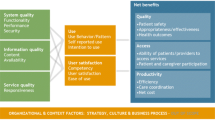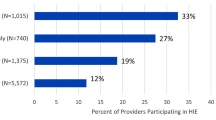Abstract
Health information exchange (HIE) makes previously inaccessible data available to clinicians, resulting in more complete information. This study tested the hypotheses that HIE information access reduced emergency room visits and inpatient hospitalizations for ambulatory care sensitive conditions among medically indigent adults. HIE access was quantified by how frequently system users’ accessed patients’ data. Encounter counts were modeled using zero inflated binomial regression. HIE was not accessed for 43% of individuals. Patient factors associated with accessed data included: prior utilization, chronic conditions, and age. Higher levels of information access were significantly associated with increased counts of all encounter types. Results indicate system users were more likely to access HIE for patients for whom the information might be considered most beneficial. Ultimately, these results imply that HIE information access did not transform care in the ways many would expect. Expectations in utilization reductions, however logical, may have to be reevaluated or postponed.


Similar content being viewed by others
References
U.S. General Accounting Office, Medical ADP systems: automated medical records hold promise to improve patient care. Washington, D.C., 1991.
Institute of Medicine, Crossing the quality chasm: A new health system for the 21st century. National Academy, Washington, D.C., 2001.
Institute of Medicine, The computer-based patient record: an essential technology for health care. revised edition. In: Dick, R. S., Steen, E. B., and Detmer, D. E. (Eds.), National Academy, Washington, D.C., 1997.
National Research Council, Networking health: prescriptions for the internet. National Academy, Washington, D.C., 2000.
Gandhi, T. K., Sittig, D. F., Franklin, M., et al., Communication breakdown in the outpatient referral process. J. Gen. Intern. Med. 15(9):626–631, 2000. doi:10.1046/j.1525-1497.2000.91119.x.
Finnell, J. T., Overhage, J. M., Dexter, P. R., et al., Community clinical data exchange for emergency medicine patients. AMIA Annual Symposium Proceedings 235–238, 2003
Smith, P. C., Araya-Guerra, R., Bublitz, C., et al., Missing clinical information during primary care visits. JAMA. 293(5):565–571, 2005. doi:10.1001/jama.293.5.565.
Institute of Medicine, To err is human, building a safer health system. In: Kohn, L. T., Corrigan, J. M., and Donaldson, M. S. (Eds.), National Academy, Washington, D. C., 2000.
Kalra, J., Medical errors: an introduction to concepts. Clin. Biochem. 37:1043–1051, 2004.
Institute of Medicine. Fostering rapid advances in health care: learning from system demonstrations. In: Corrigan, J., Greiner, A, and Erikson, S. (Eds), Washington, D.C.: National Academy Press, 2003
Bieszk, N., Patel, R., Heaberlin, A., et al., Detection of medication nonadherence through review of pharmacy claims data. Am. J. Health Syst. Pharm. 60(15):360–366, 2003.
Casalino, L., Gillies, R. R., Shortell, S. M., et al., External incentives, information technology, and organized processes to improve health care quality for patients with chronic diseases. JAMA. 289(4):434–441, 2003. doi:10.1001/jama.289.4.434.
Gamm, L., Bolin, J. N., and Kash, B. A., Organizational technologies of chronic disease management programs in large rural multispecialty group practice systems. J. Ambul. Care Manage. 28(3):210–221, 2005.
Kilo, C. M., Transforming care: Medical practice design and information technology. Health Aff. 24(5):1296–1301, 2005. doi:10.1377/hlthaff.24.5.1296.
Shapiro, J. S., Kannry, J., Lipton, M., et al., Approaches to patient health information exchange and their impact on emergency medicine. Ann. Emerg. Med. 48(4):426–432, 2006. doi:10.1016/j.annemergmed.2006.03.032.
Schoen, C., How, S. K. H., Weinbaum, I., et al., Public views on shaping the future of the U.S. health system. The Commonwealth Fund, New York, NY, 2006.
Biondich, P. G., and Grannis, S. J., The Indiana network for patient care: an integrated clinical information system informed by over thirty years of experience. J. Public Health Manag. Pract. (S81–6), 2004.
Frisse, M. E., and Holmes, R. L., Estimated financial savings associated with health information exchange and ambulatory care referral. Journal of Biomedical Informatics. 40(6 S1):S27–S32, 2007.
Walker, J., Pan, E., Johnston, D., et al., The value of health care information exchange and interoperability. Health Aff, 2005. hlthaff.w5.10.
United States Government Accountability Office, Health and Human Services’ Estimate of Health Care Cost Savings Resulting from the Use of Information Technology 2005.
Hripcsak, G., Kaushal, R., Johnson, K. B., et al., The United Hospital Fund meeting on evaluating health information exchange. J. Biomed. Inform. 40(Supplement 1(6)):S3–S10, 2007. doi:10.1016/j.jbi.2007.08.002.
Billings, J., Zeitel, L., Lukomnik, J., et al., Impact of socioeconomic status on hospital use in New York City. Health Aff. (Millwood). 12(1):162–173, 1993. doi:10.1377/hlthaff.12.1.162.
Baker, L. C., and Baker, L. S., Excess cost of emergency department visits for nonurgent care. Health Aff. 13(5):162–171, 1994. doi:10.1377/hlthaff.13.5.162.
Ruger, J. P., Richter, C. J., Spitznagel, E., et al., Analysis of costs, length of stay, and utilization of emergency department services by frequent users: implications for health policy. Acad. Emerg. Med. 11(12):1311–1317, 2004.
Zuckerman, S., and Shen, Y. C., Characteristics of occasional and frequent emergency department users: do insurance coverage and access to care matter? Med. Care. 42(2):176–182, 2004. doi:10.1097/01.mlr.0000108747.51198.41.
Overhage, J. M., Evans, L., and Marchibroda, J., Communities’ readiness for health information exchange: the National Landscape in 2004. J. Am. Med. Inform. Assoc. 12(2):107–112, 2005. doi:10.1197/jamia.M1680.
Marchibroda, J. M., Health information exchange policy and evaluation. Journal of Biomedical Informatics. 40(6 S1):S11–S16, 2007.
Hripcsak, G., Developing common methods for evaluating health information exchange. Journal of Biomedical Informatics. 40(6 S1):S1–S2, 2007.
Chaudhry, B., Wang, J., Wu, S., et al., Systematic review: impact of health information technology on quality, efficiency, and costs of medical care. Ann. Intern. Med. 144(10):742–752, 2006.
Overhage, J., Deter, P., Perkins, S., et al., A randomized, controlled trial of clinical information shared from another institution. Ann. Emerg. Med. 39(1):14–23, 2002. doi:10.1067/mem.2002.120794.
Lang, E., Afilalo, M., Vandal, A. C., et al., Impact of an electronic link between the emergency department and family physicians: a randomized controlled trial. CMAJ. 174(3):313–318, 2006. doi:10.1503/cmaj.050698.
Solomon, M. R., Regional health information organizations: a vehicle for transforming health care delivery? J. Med. Syst. 31(1):35–47, 2007. doi:10.1007/s10916-006-9041-0.
Burton, L. C., Anderson, G. F., and Kues, I. W., Using electronic health records to help coordinate care. Milbank Q. 82(3):457–481, 2004. doi:10.1111/j.0887-378X.2004.00318.x.
Ansari, Z., Laditka, J. N., and Laditka, S. B., Access to health care and hospitalization for ambulatory care sensitive conditions. Med. Care Res. Rev. 63(6):719–741, 2006. doi:10.1177/1077558706293637.
Pappas, G., Hadden, W. C., Kozak, L. J., et al., Potentially avoidable hospitalizations: inequalities in rates between US socioeconomic groups. Am. J. Public Health. 87(5):811–816, 1997.
Indigent Care Collaboration of Central Texas. Summaries of ICC Major Initiatives 2002–2003. 2003 [cited 2007 Sept 6th]; Available from: http://www.icc-centex.org/library/updates/Summaries%20of%20ICC%20Major%20Initiatives%202002–03.pdf.
Shi, L., Samuels, M. E., Pease, M., et al., Patient characteristics associated with hospitalizations for ambulatory care sensitive conditions in South Carolina. South. Med. J. 92(10):989–998, 1999.
Klabunde, C. N., Warren, J. L., and Legler, J. M., Assessing comorbidity using claims data: An overview. Med. Care. 40(8):IV26–IV35, 2002. doi:10.1097/00005650-200208001-00004.
de Groot, V., Beckerman, H., Lankhorst, G. J., et al., How to measure comorbidity: a critical review of available methods. J. Clin. Epidemiol. 56(3):221–229, 2003. doi:10.1016/S0895-4356(02)00585-1.
Okuyemi, K. S., and Frey, B., Describing and predicting frequent users of an emergency department. J. Assoc. Acad. Minor. Phys. 12(1–2):119–123, 2001.
Kleinbaum, D. G., and Klein, M., Logistic Regression, 2nd edition. Springer, New York, 2002.
Long, J. S., and Freese, J., Regression models for categorical dependent variables using Stata, 2nd edition. Stata, College Station, TX, 2006.
Hilbe, J. M., Negative binomial regression. Cambridge University Press, Cambridge, NY, 2007.
Wilcox, A., Kuperman, G., Dorr, D. A., et al., Architectural strategies and issues with health information exchange. AMIA Annual Symposium Proceedings 814–818, 2006.
Elson, R. B., Faughnan, J. G., and Connelly, D. P., An industrial process view of information delivery to support clinical decision making: implications for systems design and process measures. J. Am. Med. Inform. Assoc. 4(4):266–278, 1997.
Haigh, S., Megarity, J., Measuring web site usage: Log file analysis. Network Notes 1998 [cited Oct 9, 2007]; Available from: www.collectioncanada.ca/9/1/pl-256-e.html.
Afifi, W. A., and Weiner, J. L., Toward a theory of motivated information management. Commun. Theory. 14(2):167–190, 2004. doi:10.1111/j.1468-2885.2004.tb00310.x.
González-González, A. I., Dawes, M., Sánchez-Mateos, J., et al., Information needs and information-seeking behavior of primary care physicians. Ann. Fam. Med. 5(4):345–352, 2007. doi:10.1370/afm.681.
Pluye, P., Grad, R. M., Dawes, M., et al., Seven reasons why health professionals search clinical information-retrieval technology (CIRT): Toward an organizational model. J. Eval. Clin. Pract. 13(1):39–49, 2007. doi:10.1111/j.1365-2753.2006.00646.x.
Nygren, E., and Henriksson, P., Reading the medical record. I. Analysis of physicians’ ways of reading the medical record. Comput. Methods Programs Biomed. 39(1–2):1–12, 1992. doi:10.1016/0169-2607(92)90053-A.
Colley, C., and Lucas, L., Polypharmacy. J. Gen. Intern. Med. 8(5):278–283, 1993. doi:10.1007/BF02600099.
Ely, J. W., Osheroff, J. A., Chambliss, M. L., et al., Answering physicians’ clinical questions: obstacles and potential solutions. J. Am. Med. Inform. Assoc. 12(2):217–224, 2005. doi:10.1197/jamia.M1608.
Institute of Medicine. Access to health care in America. In: Millman, M (Ed), Washington, D.C.: National Academy, 1993.
Ash, J. S., and Guappone, K. P., Qualitative evaluation of health information exchange efforts. J. Biomed. Inform. 40(Suppl 1(6)):S33–S39, 2007. doi:10.1016/j.jbi.2007.08.001.
Gamm, L. D., Barsukiewicz, C. K., Dansky, K. H., et al., Pre- and post-control model research on end-users’ satisfaction with an electronic medical record: preliminary results. Proc AMIA Symp. 225–229, 1998.
Dansky, K. H., Gamm, L. D., Vasey, J. J., et al., Electronic medical records: Are physicians ready?/Practitioner application. J. Healthc. Manag. 44(6):440, 1999.
Tornatzky, L. G., and Fleischer, M., The processes of technological innovation. Lexington Books, Lexington, MA, 1990.
Zhu, K., Kraemer, K. L., and Xu, S., The process of innovation assimilation by firms in different countries: A technology diffusion perspective on e-business. Manage. Sci. 52(10):1557–1576, 2006. doi:10.1287/mnsc.1050.0487.
Rogers, E. M., Diffusion of innovations, 5th edition. Free Press, New York, 2003.
Labkoff, S. E., and Yasnoff, W. A., A framework for systematic evaluation of health information infrastructure progress in communities. J. Biomed. Inform. 40(2):100–105, 2007. doi:10.1016/j.jbi.2006.01.002.
Acknowledgements
The author thanks the staff of the Integrated Care Collaboration of Central Texas, particularly Sandy Coe Simmons; and from TAMHSC SRPH Dr. Charles Phillips, SangNam Ahn, Patricia Moore, Darcy Moudouni and Laura Wills for helpful comments and suggestions.
Author information
Authors and Affiliations
Corresponding author
Rights and permissions
About this article
Cite this article
Vest, J.R. Health Information Exchange and Healthcare Utilization. J Med Syst 33, 223–231 (2009). https://doi.org/10.1007/s10916-008-9183-3
Received:
Accepted:
Published:
Issue Date:
DOI: https://doi.org/10.1007/s10916-008-9183-3




